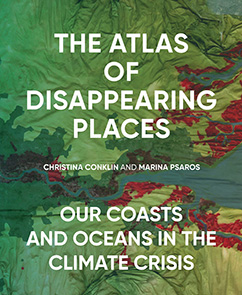“An atlas of places that are likely to be transformed beyond recovery over the next decades may seem like a sad theme for a book. Yet Christina Conklin and Marina Psaros have produced a thing of beauty, a testament as gorgeous as the places it sears into our memory. If we do not care, we will not make the effort to save our world. Readers will find themselves caring deeply, and that at least is a first step.”—Richard Heinberg, senior fellow, Post Carbon Institute |
“Beautiful maps and hopeful vignettes about the future temper this important book about climate change in our world.”—Library Journal |
“You are holding a surprising, enlightening, hopeful book. Readers visit twenty places, immersed in the authors’ deeply researched reporting; the most heartening stories are the authors’ views of the next few decades, showing that positive change is easy to envision and realistic. The art alone speaks volumes about what is possible: for the human heart-mind to envision and pursue a beautiful way through this crisis, out to a more humane and life-affirming future.”—Carl Safina, author of Becoming Wild: How Animal Cultures Raise Families, Create Beauty, and Achieve Peace |
“The Atlas of Disappearing Places offers warnings no one wants to hear, though now we ignore them at our peril. Readable, informative, and terrifying, this important book is simultaneously global and local, affecting every aspect of our lives, inland as well as on the coasts. Read it . . . and weep . . . and act. As the seas rise, so must we.”—Lucy R. Lippard, curator of Weather Report: Art and Climate Change |
“A striking and deeply researched work of art and environmental activism.”—BookPage |
“The rare coffee table book that’s also a call to arms.”—Chicago Review of Books |
“A beautiful work of art and an indispensable resource to learn more about the devastating consequences of the climate crisis, The Atlas of Disappearing Places will engage and inspire readers on the most pressing issue of our time.”—Yale Climate Connections |
“An extraordinary journey on the frontiers of scientific understanding into life’s exquisitely complex interdependence communicated by master storytellers. At once captivating and deeply informative. Terrifying and hopeful, a must-read for all who care.”—David Korten, author of When Corporations Rule the World, The Great Turning: From Empire to Earth Community, and Change the Story, Change the Future: A Living Economy for a Living Earth |
|
“Painted with water-soluble inks on sheets of dried seaweed, the book’s maps are textured, attractive, and informative. . . . Climate change is not just about melting ice caps and starving polar bears, and The Atlas of Disappearing Places brings that reality home.”—Foreword Reviews |
“The Atlas of Disappearing Places grasps the depth and breadth of change taking place. Creative, informative, and provocative, it presents us with artful surprises, poignant anecdotes, and memorable facts. I highly recommend it.”—John Englander, oceanographer, author of Moving to Higher Ground: Rising Sea Level and the Path Forward |
“A deeply researched, artistic, heartfelt introspection of our intimate connection to Earth, and industrialized humans’ catastrophic impact upon Her. Illuminating how every decision we make impacts the planet, and thus ourselves, this rare work articulates a stark view of where we are heading, alongside possible mitigation avenues if we are to heed these blaring alarms from the front lines.”—Dahr Jamail, author of The End of Ice: Bearing Witness and Finding Meaning in the Path of Climate Disruption |
“The Atlas of Disappearing Places is a story told through art and science that takes us on a journey across the planet through the throwaway culture of plastic waste and the toxic culture of fertilisers and pesticides and dead zones. It is not just a story of climate change. It is also a story of extinction. A must-read for anyone who cares about the future of the planet and people.”—Vandana Shiva |
“After delving into Christina Conklin and Marina Psaros’ engaging and sometimes enraging The Atlas of Disappearing Places: Our Coasts and Oceans in the Climate Crisis, you may find it difficult to remain passive about climate change for a whole lot longer.”—San Francisco Chronicle |
“A treat for anyone up for a systematic exploration of climate change’s effects on coastal communities around the world.”—The Provincetown Independent |
“A colorful global tour filled with artistic maps and imagined views from a 2050 when many problems have been addressed.”—Bloomberg |
|





